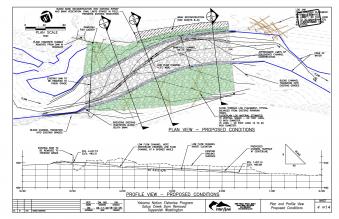Satus Dam—also known as the Shadduck Dam—was installed in Satus Creek over a half-century ago by Wapato Irrigation Project (WIP). The dam was used to divert water to supplement the irrigation water in the Satus District of WIP. The diversion had been obsolete for over 20 years and WIP intended to remove the dam, but lacked funding.
The dam spanned Satus Creek and had about a two-foot drop with a fish ladder along the left side. The dam was a fish passage barrier (the fish ladder was frequently blocked with debris) and offered easy poaching opportunities. Yakama Nation Fisheries (YNF) decided to remove the dam to improve fish passage for Mid-Columbia ESU Steelhead.
YNF proposed removing the dam to a finished grade and remove the fish ladder. A roughened channel would allow unimpeded fish passage, grade control, and fish habitat.
- Remove fish passage barrier,
- Remove poaching opportunity, and
- Establish stream grade.
The roughened channel concept was designed by a firm with experience in hydraulic engineering and geomorphology. The firm performed a reach assessment of the area to analyze design alternatives and determine the most efficient plan for the project.
Rock for this project was sorted and staged onsite prior to beginning the work. A tracked excavator was used to remove the concrete dam and fish ladder, and install the rocks that formed the roughened channel.
To prevent excessive sedimentation during construction activities, stream flow was diverted out of/around the construction area, and work was conducted during historic base flow periods. All heavy equipment that operated in or around the stream used non-toxic hydraulic fluid for environment and water quality safety measures. Cofferdams were used to isolate the stream to the right channel during construction of the main channel. Removal of the construction water was pumped into the existing ditch that ran adjacent to the dam.
The target fish species for this project was Mid-Columbia ESU Steelhead. The objective of this project was to breach a 65-foot wide concrete dam that had about a two-foot drop with a fish ladder along the left side. During low flows it would interfere with fish migration, and it had been reported that the ladder would be blocked to allow poachers easy access to catch up-migrating steelhead. Breaching of this dam and the roughened channel improved migration up- and down-stream as well as fish habitat in this area.
The roughened channel was developed by using the cross section of the upstream and downstream of the dam. The channel was sized to match bank full channel capacity through the project reach. Channel roughness elements had protruding boulders which reduced the potential of supercritical flow conditions at the crest of the roughened channel and episode of a hydraulic jump. The roughened channel was designed to mimic the natural stream system.
The flood plain roughness was achieved by placing large woody debris in the area that would/will likely cause recruitment of debris during high flows events. Flood plain revegetation was accomplished using a stinger attachment, which is used for planting at severely compacted sites, gravel bars along streams, and steep road cut and fill slopes. The stinger can plant five to six feet deep and accommodate various plant sizes, including one-gallon trees. Many riparian plant species require "having their feet wet" to properly establish. The stinger can pierce the ground and insert plants at a rate of five seedlings or cuttings per minute, providing rapid and efficient planting. All disturbed soil on the flood plain was hydro seeded with native vegetation.
YRWP staff has successfully removed the first dam on the Yakama Reservation. Staff is confident that this project will allow improved access to key habitat for Mid-Columbia ESU steelhead in the Upper Satus Creek Watershed.
Status: Active
08/01/2009 - PresentProject Manager
-
Shannon Adams ,
Technical Services Coordinator
509-945-0754


